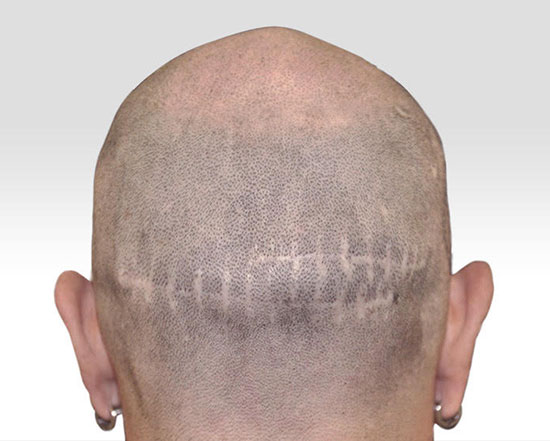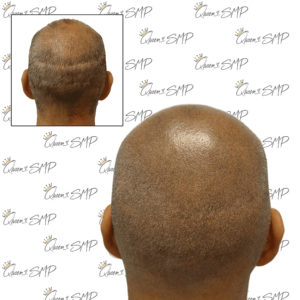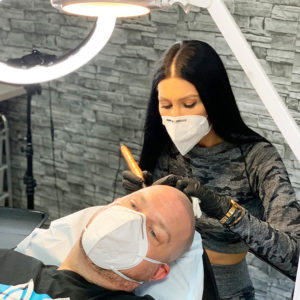Hair transplant scars are a source of stress and anxiety for many men (and some women) who have had hair restoration surgery. Hair transplant scars can be a non-issue in the period immediately after getting a surgery, since they will be in an area that’s covered by the rest of your hair. However, hair loss is often progressive. As time goes on and a person who had a hair transplant loses more of their hair, they have less hair to cover their scars. When a person’s hair density becomes thin, they may end up deciding that they’d look better if they shaved their head– but doing that would expose their scars. This can leave a person feeling like they’re in a lose-lose situation, since they feel like they have to either deal with wearing longer hair that’s now too thin or shaving their head and exposing their scars.
Fortunately for those dealing with scars on their scalp, Scalp Micropigmentation can be used to blend scar tissue in with the rest of your scalp. By carefully placing a gradient of new pigments over multiple sessions, the appearance of your scars can be significantly reduced. SMP can be effective at camouflaging multiple types of scars, including:
- Follicular Unit Extraction (FUE) Scars: These scars are left behind after a punch tool is used to extract hair grafts from a donor site, which is often on the back of the head. FUE scars look like small “dots,” and are often laid out in a grid pattern.
- Follicular Unit Transplant (FUT) Scars: Follicular Unit Transplants are also called the strip method, since it takes donor follicular units from a strip of the scalp. An FUT surgery leaves behind a thin linear scar that can be as small as six inches long or may stretch from ear to ear.
FAQ
Why did I scar after my hair transplant?
The most common type of hair transplant that causes scarring is called Follicular Unit Transplantation (FUT). This process takes a strip of tissue from the back of your head, seals the cut, then divides it up for transplantation into your scalp. It’s a quick procedure, but there is a risk of scarring on the back of the head.
Do all hair transplant methods cause scarring?
Not necessarily. Doctors have improved their methods of moving and transplanting hair follicles. Techniques like Follicular Unit Extraction can leave next to no scars, but the process takes longer and is more expensive. However, even FUE can cause visible dots of scar tissue if enough hair is moved. Fortunately, SMP can cover up even these tiny scars!
How well does it blend?
You may still have hair surrounding the scarred area, so the buzzed head look may not be the best. Fortunately, we can use other SMP techniques to make the area look filled in a way that matches your current hair length.





